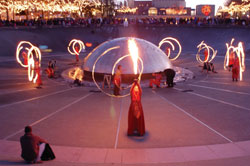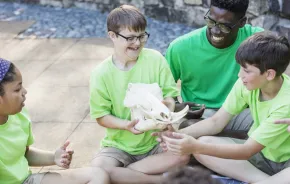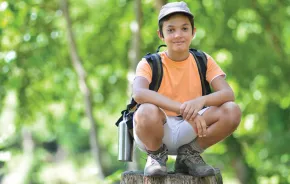
For those of us with a diverse group of family and friends, celebrating the winter holiday season can be awkward. But the winter solstice is a holiday that we in the Pacific Northwest can all celebrate — no matter what our religious or cultural backgrounds.
As the earth travels around the sun in its annual orbit, the north-south position of the sun changes in relation to the orientation of the earth’s tilted rotation axes, resulting in the seasons. The Northern Hemisphere’s winter solstice occurs when the sun is farthest south, resulting in the shortest day of the year. As the earth passes this halfway mark around the sun, the days begin to get longer; spring is on the horizon.
Since the dawn of time, humans have been commemorating this return of the light with ritual and celebration. Though my family and I celebrate the winter solstice, I did not truly understand its significance until we went without power for four days following last December’s catastrophic windstorm. As I hurried to accomplish what I could within the few hours of daylight available, I began to dread the setting sun that would herald another long stretch of darkness and cold. I imagined what it must have been like for ancient peoples with only fire to stave off the frigid night.
Without an understanding of the science behind the seasons, ancient people feared that the sun might not return and the earth would be plunged into eternal darkness. Neighbors joined forces in the spirit of goodwill to ensure the sun’s rebirth.
Many contemporary traditions came from those ancient times. Scandinavians celebrated with a feast and burned the Yule log. Northern Europeans lit great bonfires and tied apples to the branches of fir trees to remind themselves of the coming summer. Others placed burning candles in the branches of evergreens. The Celts decorated with mistletoe and holly in celebration of the living green. Early Romans gave gifts to friends and family. Even our carols have ancient roots: “See the blazing Yule before us … Fast away the old year passes … Hail the new year, lads and lasses.”
Today, celebrating the solstice can be as simple as a family candle-lighting ceremony or as elaborate as a community event. These activities can be ways to rediscover the roots of the holidays, throw in a little science education, and take some time out from the commercialism that often overshadows the true spirit of the season.
Before the solstice
Craft projects and science experiments can help children understand the significance of the change of seasons and its effect on nature.
Create natural birdfeeders by spreading peanut butter into the crevices of pinecones (collected from our many parks), then rolling the pinecones in birdseed. Hang these, along with bits of dried fruit, in your trees and shrubs to attract birds to your yard to help them find enough food during the shorter days.
The science of the solstice can be explained to young children using an orange, toothpicks and a flashlight. Stick a toothpick in the top and bottom of the orange to represent the earth and its poles. In a dark room, shine the flashlight (the sun) directly at the center part of the orange (the earth’s equator). Tilt the top toothpick (North Pole) slightly toward the light — most of the light will shine on the top of the orange. This illustrates the position of the sun and earth during the Northern Hemisphere’s summer. Then, tilt the top toothpick slightly away from the “sun” to see the position of the earth during the winter solstice, when the Northern Hemisphere receives less light. This also demonstrates how the equator does not experience seasons, as the amount of light (and warm temperatures) are fairly constant throughout the year.
This is a great time of year to read stories about the change of seasons, migratory birds, hibernating animals, and how animals that don’t hibernate survive the cold weather and barren landscapes.
On the solstice
If you’re lucky enough to live in an area that has a community celebration, attend and enjoy. In Seattle, there’s something for everyone, from the extravagant spectacle at the Seattle Center to the low-tide moonlight beach walks at Camp Long and Lincoln Park.
For those who want a close-knit, homey celebration, invite family and friends for dinner on the solstice. In advance, place candles in every room of your house, with one large, golden “sun” candle in a prominent place. Use sturdy holders or votives for safety. Before the meal, as the sun sets (6:12 p.m. PST) turn off every light in the house. While enveloped in darkness, have someone give a reading. An example is:
For half of the year, day by day, slowly the world has grown darker.
For half the year, night by night, slowly the dark has grown longer.
Tonight that ends and the wheel turns us back to the light.
Light the sun candle and have the group recite a second reading:
The darkness was never complete.
A spark was always waiting to return and burn again.
The wheel is turning and light’s returning.
Proceed as a group through the house and light each candle, flooding the space with light. If you have a fireplace, fire up your Yule log. Those who put up a tree can plug in the lights — remember to save the trunk for next year’s Yule log. Share a meal by candlelight and give thanks for all that brings light to the world. Ask friends or family who play instruments to provide music, or listen to one of the many CDs of music composed to honor the solstice.
For a more contemplative celebration, take a family outing to a favorite vantage spot to watch the sunset. At West Seattle’s Solstice Park, the setting sun illuminates a strategically placed granite marker. Where permitted, light a bonfire and investigate the night sky. Or take a walk at dusk in one of our many parks, returning home for a quiet evening of games and reading around the fire — relying as little on electric light as possible.
Whatever you choose to do on the solstice, reflect on how our ancestors conquered their fears of the dark and opted instead for the hope that light would return. This is a lesson we can all take with us every day of the year.
Andrea Leigh Ptak is a freelance writer and graphic designer who lives with her family in South Seattle and has been celebrating the winter solstice for the past 15 years.
Resources
Books:
The Winter Solstice by Ellen Jackson, illustrated by Jan
Davey Ellis (The Millbrook Press). The perfect book to explain the
solstice to young children, it highlights the science of the solstice
and how it was celebrated over the world.
Celebrating the Great Mother: A Handbook of Earth-Honoring Activities for Parents and Children
by Cait Johnson and Maura D. Shaw (Destiny Books). The authors lead you
through a year of earth-based festivals, projects, special meals and
family traditions.
Wheel of the Year: Living the Magical Life by Pauline
Campanelli, illustrated by Dan Campanelli (Llewellyn Publications). A
nature-based guide through the turnings of the year with crafts and
rituals.
Web sites:
Seattle Post-Intelligencer article on daylight savings, which features a great diagram of the earth’s trip around the sun: http://seattlepi.nwsource.com/local/337944_timeclock03.html
Winter Solstice: History, Celebration and Science: www.chiff.com/a/winter-solstice.htm
Eric Weisstein’s World of Astronomy — the science of the solstice: http://scienceworld.wolfram.com/astronomy/Solstice.html









